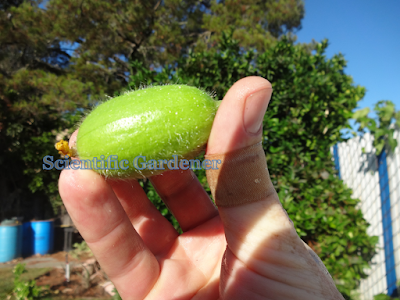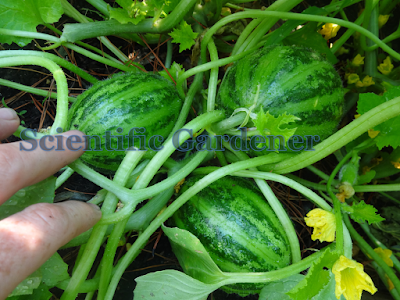Even the focus of this post mainly concerns carosello (which are a type of C. melo) these cucumber-melons still grow much like regular cucumbers. Though the application of crop isolation here is in a monecious flower (such as vining crops and corn), the principles of isolation that are described here can be utilized for any crop type that requires isolation from insect pollinators.
With the incredible variations of color, shape, size and texture that distinguish one carosello variety from another it can be very difficult for any gardener to grow out more than two carosello varieties in one garden over the course of one year. There are different ways to isolate cucumbers. One way is to isolate them by distance. In areas without barriers or dense foliage between varieties a minimum distance of 1 mile is recommended. Another option is to grow one variety until there are no more flowers that can pollinate a second cucumber variety. What if you want to grow multiple cucumber varieties to seed at the same time? What options are there? In 2018 I decided to try three different carosello varieties at the same time. I had no idea what they would grow to become or if I would want to save the seed, but I figured that I would cross that bridge once I got there.
The below figure shows how the three carosello varieties grew. Either because of differences in lighting or genetics, the Carosello Medium Long of Barese began producing male flowers first, followed by the unknown carosello variety, followed by the Medium Long of Tarantino.
The red, yellow and blue represent times in which the plant was not being impacted by another variety while the orange and green represent times in which there was an overlap in pollination of one variety and another. Looking back on this illustration, the time period of overlap is much longer than the time period without an overlap of pollination.
For those who are not familiar with monecious vining fruit development, there will usually be many male flowers that begin forming on the plant long before the female fruit begin to grow. Thus, there are generally unused male flowers for a space of time until the female flowers begin to form. When growing one carosello variety, the bees transfer pollen from male flowers to the female flowers of the same cultivar, keeping the variety genetically pure. The first variety to produce female flowers, the Medium Long of Barese had female flowers that were pollinated by both its own male flowers as well as the unknown carosello. This could have been a problem had I wanted to save the seed, but because I decided not to save this variety for seed, I pulled the cucumbers before they produced seed. By the time I began growing the other two carosello varieties, I had pulled the Medium Long of Barese. Pulling the whole plant is only one option to isolating cucumber varieties.
Pulling the female fruit is something that I had to do with the first batch of female fruit that were produced unknown carosello variety. Once I realized that I wanted to keep seed from the unknown carosello cucumber I did two things. First, I pulled all the male flowers from the Medium Long of Tarantino. Then I pulled all female flowers from the unknown variety – as these may have crossed. Finally, I put small mesh bags over the female flowers to keep bees from pollinating the flowers. As some wild bees can be very small, it is important that if a gardener chooses to do this, that the mesh be small enough to keep these bees from accessing the female flower. This method requires checking the female flowers each morning, as the window of fertility for some female flowers can be anywhere between 24 and 48 hours long.
From this point on, I hand pollinated several of the unknown carosello cucumbers. Once I had hand-pollinated these cucumbers, I used bread ties to mark the selfed (pure) fruit. Then, after the Medium Long of Tarantino began producing female fruit, I pulled all the male flowers off of the unknown carosello variety.
So –if you want to grow multiple varieties of cucumber at the same time here are a few ideas:
1. Do not allow the female flowers from all but one of the varieties to fully mature at any one time.
2. Pull all the male flowers from all varieties you do not want pollinating other female flowers.
3. Once a female fruit or two have set on one plant, remove all other side branching vines (that are not supporting that fruit) and male flowers to eliminate crossing with a second plant.
4. Use a barrier to keep pollinators from doing their job. This can be something like mesh or even
something like an enclosed greenhouse.
5. Put out transplants very early in the season so that the fruit can be hand-pollinated before bees find your plants.
 |
| Putting a mesh bag on a female carosello flower |
 |
| Once bees begin pollinating, isolation is required for variety purity |
With the incredible variations of color, shape, size and texture that distinguish one carosello variety from another it can be very difficult for any gardener to grow out more than two carosello varieties in one garden over the course of one year. There are different ways to isolate cucumbers. One way is to isolate them by distance. In areas without barriers or dense foliage between varieties a minimum distance of 1 mile is recommended. Another option is to grow one variety until there are no more flowers that can pollinate a second cucumber variety. What if you want to grow multiple cucumber varieties to seed at the same time? What options are there? In 2018 I decided to try three different carosello varieties at the same time. I had no idea what they would grow to become or if I would want to save the seed, but I figured that I would cross that bridge once I got there.
 |
| Another carosello is bagged |
The below figure shows how the three carosello varieties grew. Either because of differences in lighting or genetics, the Carosello Medium Long of Barese began producing male flowers first, followed by the unknown carosello variety, followed by the Medium Long of Tarantino.
The red, yellow and blue represent times in which the plant was not being impacted by another variety while the orange and green represent times in which there was an overlap in pollination of one variety and another. Looking back on this illustration, the time period of overlap is much longer than the time period without an overlap of pollination.
 |
| As the female fruit develops, the mesh bags can be removed |
For those who are not familiar with monecious vining fruit development, there will usually be many male flowers that begin forming on the plant long before the female fruit begin to grow. Thus, there are generally unused male flowers for a space of time until the female flowers begin to form. When growing one carosello variety, the bees transfer pollen from male flowers to the female flowers of the same cultivar, keeping the variety genetically pure. The first variety to produce female flowers, the Medium Long of Barese had female flowers that were pollinated by both its own male flowers as well as the unknown carosello. This could have been a problem had I wanted to save the seed, but because I decided not to save this variety for seed, I pulled the cucumbers before they produced seed. By the time I began growing the other two carosello varieties, I had pulled the Medium Long of Barese. Pulling the whole plant is only one option to isolating cucumber varieties.
 |
| Example of pulling the female fruit to maintain purity (more will develop) |
Pulling the female fruit is something that I had to do with the first batch of female fruit that were produced unknown carosello variety. Once I realized that I wanted to keep seed from the unknown carosello cucumber I did two things. First, I pulled all the male flowers from the Medium Long of Tarantino. Then I pulled all female flowers from the unknown variety – as these may have crossed. Finally, I put small mesh bags over the female flowers to keep bees from pollinating the flowers. As some wild bees can be very small, it is important that if a gardener chooses to do this, that the mesh be small enough to keep these bees from accessing the female flower. This method requires checking the female flowers each morning, as the window of fertility for some female flowers can be anywhere between 24 and 48 hours long.
From this point on, I hand pollinated several of the unknown carosello cucumbers. Once I had hand-pollinated these cucumbers, I used bread ties to mark the selfed (pure) fruit. Then, after the Medium Long of Tarantino began producing female fruit, I pulled all the male flowers off of the unknown carosello variety.
 |
| Maintaining Cucumber purity through pulling off male flowers |
 |
| A pile of mostly unused male flowers |
 |
| It can be difficult to keep up with pulling flowers to maintain variety purity |
 |
| The bread tie signifies a selfed (pure) fruit for seed |
So –if you want to grow multiple varieties of cucumber at the same time here are a few ideas:
1. Do not allow the female flowers from all but one of the varieties to fully mature at any one time.
2. Pull all the male flowers from all varieties you do not want pollinating other female flowers.
3. Once a female fruit or two have set on one plant, remove all other side branching vines (that are not supporting that fruit) and male flowers to eliminate crossing with a second plant.
4. Use a barrier to keep pollinators from doing their job. This can be something like mesh or even
something like an enclosed greenhouse.
5. Put out transplants very early in the season so that the fruit can be hand-pollinated before bees find your plants.


















































